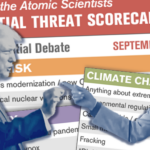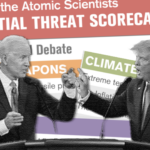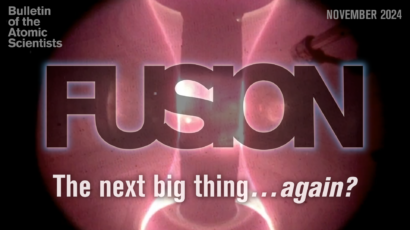Women’s Work
By Lovely Umayam | April 9, 2014
In the early 1940s, at the Y-12 National Security Complex in Oak Ridge, Tennessee, women filed off of buses every day and shuffled into their respective buildings ready for another day’s work. Some of these women were in charge of operating calutrons —mass spectrometers which separate uranium isotopes—at the facility, but were unaware of this fact or the larger purpose of their efforts. According to The Girls of Atomic City by Denise Kiernan, the women were told to monitor gauges and press buttons when certain needles veered left or right, but given nothing more than these instructions. They gradually honed their craft by piecing bits of information together, and taking great care that certain needles didn’t pass the threshold, the lights remained green, and the machines continued their mild humming throughout the day. For years they toiled without question, but sometimes wondered what their positions entailed. After years of stifled curiosity, the veil of mystery was finally lifted in 1945 to reveal that they had had a hand in developing the country’s first nuclear weapons. But that moment passed quickly and the lives and work of these women were barely mentioned again.
In America’s rich nuclear narrative, the female presence is largely dismissed or diminished, even though many women helped forge a human connection with these impressive yet dangerous new technologies. It’s fair to say that women rarely come to mind when discussing historical milestones like the Manhattan Project; instead, the spotlight shines on the science, the bomb, and the men who accomplished a job well done. Women like those in the Oak Ridge complex are relegated to obscurity. But they deserve to be remembered and championed.
To be sure, the muted influence of women in nuclear history reflects the widespread gender disparities of a society that devalued women’s work. But there was an added barrier to entry unique to the brave new world of nuclear politics, best described by Carol Cohn in her 1987 essay Sex and Death in the Rational World of Defense Intellectuals. She noted how difficult it was to deconstruct what she called the “technostrategic language” of nuclear strategic analysts and defense intellectuals—lingo riddled with acronyms, euphemisms, and logic infused with militarized masculinity and male dominance. Cohn argued that not only did this language alienate those who did not speak it, but it also rendered nuclear weapons into abstract, culturally acceptable objects that do no harm. With men leading the scientific and political arenas equipped with this exclusive language, there was little opportunity for women to contribute and change the dialogue.
Those who dared would have to work absurdly hard to get noticed, perhaps only to face rejection as consequence. Worse still would be the fate of making it into the nuclear club, learning the language without question, and absorbing the status quo perspective rather than championing one’s own.
Eventually, pioneering women found ways to permeate tight policy circles. The United States has been graced with political leaders like former US Secretaries of State Hillary Clinton and Condoleeza Rice, Ambassador Bonnie Jenkins, former Undersecretary of State for Arms Control and International Security Ellen Tauscher, and the newly confirmed Undersecretary of State for Arms Control and International Security Rose Gottemoeller as some of America’s chief voices in nuclear policy. As of 2013, there were about 100 female senior-level officials in the US Departments of State and Defense and 49 female US ambassadors. And according to the latest Women in Peace and Security Careers report on US Congressional staffers, about 18.3 percent of 2014 members of Congress are women, a slight bump up from 16.8 percent in 2012.
While the presence of women in positions of power within foreign policy circles has increased in the last several decades, we still have to ask ourselves: Have women reached equality beyond the numbers? Framed this way, the answer may not be as positive. Women are still not shaping the future of foreign policy to the extent they could be; underrepresentation in the workplace remains a major factor contributing to pressure, self-censorship, and insecurity. Although women recognize that they have more opportunities in the field now than in the past, there are still only a few who have landed senior positions in national security or intelligence-related bureaus and committees. And only a sliver of the statistics cited above represent women of color.
But monitoring the rise in numbers is a simplistic way of gauging how much the well-being of women in the workforce has improved in recent years. The rise of women in traditionally male-centric fields should be weighed against deficient efforts to enhance the quality of women’s experiences in workplaces. Anne-Marie Slaughter, former director of policy planning for the US State Department and author of the influential 2012 Atlantic article Why Women Still Can’t Have it All, would argue that workplaces must recognize that women are as valuable and capable as men even if they are engaged in a balancing act between work and family. Genuinely embracing and acting on this view will shift the mood and tempo in work places, changing the ways women and men collaborate and communicate. This change will be the natural outcome of diversifying the work place with the presence of varying perspectives from men, women, and minorities.
It seems like a well wrung-out message—just look at the feminist manifestos on blogs and Twitter feeds cropping up weekly—but considering that women are systematically cited less than men in international relations publications, that women continue to grapple with the wage gap in places of political power, and that the head of a catering company charged with feeding heads of state at last month’s Nuclear Security Summit got away with dishing out weird and sexist justifications for barring female servers—we are still a long way from learning any lessons. In the context of nuclear policy, perhaps a good place to start would be the very beginning, by acknowledging the stories of the women who toiled tirelessly in Y-12 and others who represent the forgotten threads in our nuclear narrative. This is simply giving credit where credit is due.
With America’s newfound interest in reviving female empowerment à la Anne-Marie Slaughter, Facebook Chief Operating Officer Sheryl Sandberg, journalist and author Maria Shriver, and other prominent feminist figures, there is a strong push for women to explore the various modes within which they can assert their presence in the work place. The debate rages on as to whether women should overcome their own internal inhibitions by actively leaning in or fight for the right to recline to avoid overwork, one of the top causes for decreased creativity and productivity. Determining the “right” feminist manifesto can be intimidating, especially when applied to careers where work is urgent 24 hours a day, seniority trumps all, and individuality is often relentlessly crushed by bureaucracy.
But as respectable as both of these philosophies are, they lose sight of the bigger picture, which should be in and of itself an impetus for women to rise and be known: that one woman’s action to fulfill her passions is a nod of recognition for the struggles of the women in our past—women who also put blood and sweat into their work, but never had the chance to share their stories.
So whatever women decide to choose—lean in, stand up, step back, speak up—they should do it for themselves, but also draw strength from those who preceded them.
Together, we make the world safer.
The Bulletin elevates expert voices above the noise. But as an independent nonprofit organization, our operations depend on the support of readers like you. Help us continue to deliver quality journalism that holds leaders accountable. Your support of our work at any level is important. In return, we promise our coverage will be understandable, influential, vigilant, solution-oriented, and fair-minded. Together we can make a difference.
Topics: Columnists, Special Topics















